Electra, 17 Tauri (17 Tau), is a giant star of the spectral type B6, located in the constellation Taurus. With an apparent magnitude of 3.70, it is the third brightest member of the Pleiades cluster, one of the brightest and largest open clusters in the sky. Electra lies at an approximate distance of 400 light years from Earth.
Star type
Electra has the stellar classification B6 IIIe, indicating a giant star appearing bluish in colour. It has a mass about five times that of the Sun and a radius 6.06 times solar. With an effective temperature of 13,484 K, it is 940 times more luminous than the Sun. The star is a very fast spinner, with a projected rotational velocity of 181 km/s, and possibly more at the equator. The star’s estimated age is 115 million years.
Due to its high rotation rate, Electra is surrounded by a disk of ejected material around the equator and is classified as a Be star. Its equatorial radius is greater than its polar radius because the poles have flattened and the equatorial region bulges out as a result of the fast spinning rate. Consequently, the star’s surface temperature, gravity and brightness are higher at the poles. The phenomenon is known as gravity darkening. Achernar in the constellation Eridanus and Vega in Lyra are among the best-known examples.
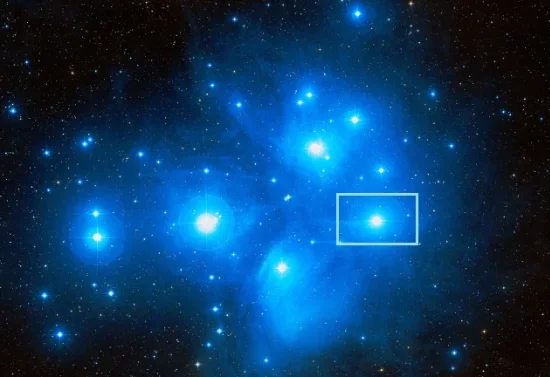
Electra (17 Tauri), image: Wikisky
Electra has a close companion less than an astronomical unit away. The two stars have an orbital period of about 100 days.
Pleiades
The Pleiades cluster, also known as Messier 45, is one of the nearest and most prominent open clusters in the sky. Containing over a thousand confirmed members and many more dim and unresolved stars, the cluster stretches across 110 arcminutes of the apparent sky and has a total mass of 800 Suns. It has an apparent magnitude of 1.6. The stars in the cluster lie at an average distance of 444 light years.
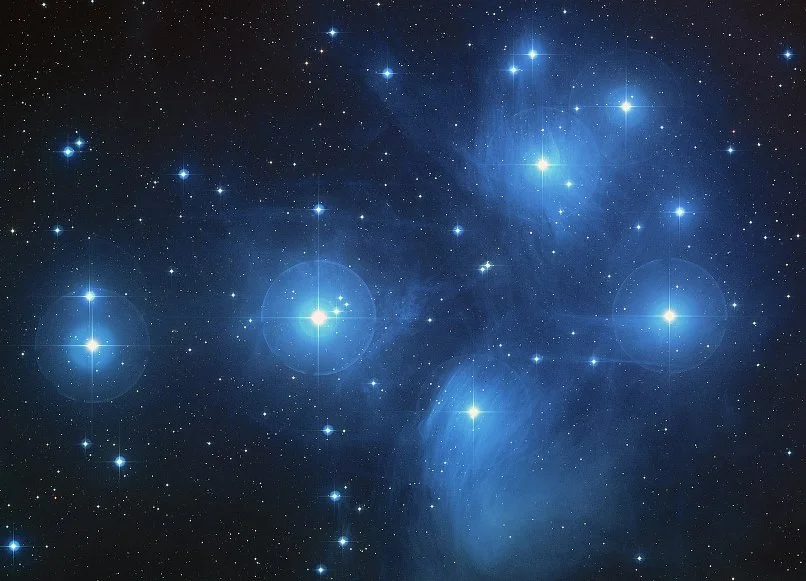
The Pleiades (M45), image: NASA, ESA, AURA/Caltech, Palomar Observatory, credit: D. Soderblom and E. Nelan (STScI), F. Benedict and B. Arthur (U. Texas), and B. Jones (Lick Obs.)
The Pleiades stars were formed in the same molecular cloud at about the same time and share a common proper motion. They have been travelling together through space for the last 100 million years (which is the estimated age of the cluster) and will continue moving in the same direction for another 250 million years. Eventually, the cluster will dissolve due to interactions with the interstellar medium.
The brightest members of the cluster are hot, luminous stars of the spectral type B. In exceptionally good conditions, observers can see up to 14 stars without binoculars. Most of the time, however, they will be able to make out only six to eight stars.
The nine brightest stars in the cluster are named after the Pleiades, the Seven Sisters in Greek mythology – Alcyone (Eta Tauri), Asterope (21 Tauri), Celaeno (16 Tauri), Electra (17 Tauri), Maia (20 Tauri), Merope (23 Tauri) and Taygeta (19 Tauri) – and their parents Atlas (27 Tauri) and Pleione (28 Tauri).
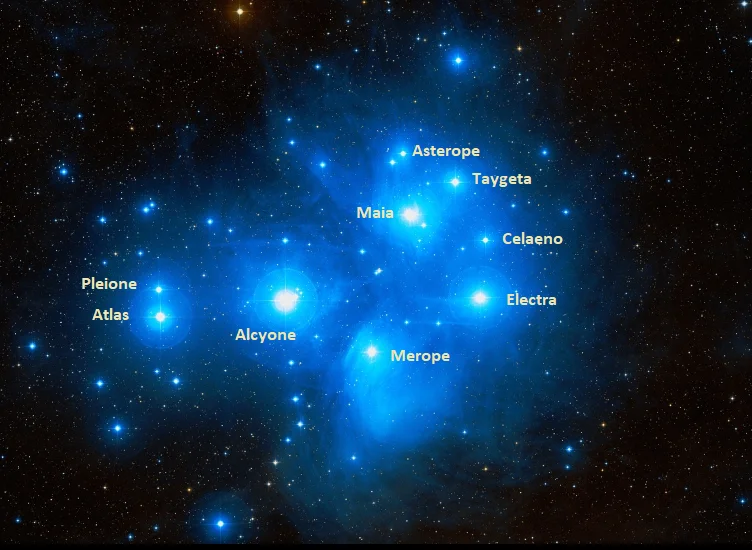
The Pleiades, image: Wikisky
In mythology, the sisters caught the eye of Orion, a giant huntsman, who began to pursue them after their father, the Titan Atlas, was condemned to uphold the heavens on his shoulders. (Atlas was punished because he was one of the Titans who had fought – and lost – a war against the Olympian gods). Zeus saw Orion pursuing the Pleiades and stepped in to protect them, transforming the sisters first into doves and then into stars to console their father. It is said that the constellation Orion still pursues the Pleiades across the sky.
Facts
The Pleiades have been known to observers around the world for millennia. The cluster was mentioned in a number of ancient texts, among others the Bible, Hesiod’s Works and Days, and Homer’s Iliad and Odyssey.
The oldest artifact depicting the cluster, the Nebra sky disk, dates back to the Bronze Age (1600 BCE). It was discovered on a site in present-day Germany in 1999 and is the oldest known depiction of the cosmos discovered anywhere in the world.
Italian astronomer and physicist Galileo Galilei was the first to observe the cluster in a telescope. He found that it contained many other stars, too faint to be seen by the unaided eye. Galilei published his notes and a sketch of the cluster in March 1610.
The Japanese know the Pleiades as Subaru. An image of the six brightest stars is used in the logo of the automobile company of the same name. In the 8th century Kojiki, an early compilation of myths, legends and oral traditions, the cluster was mentioned as Mutsuraboshi, meaning “six stars.”
Name
The name Electra (pronunciation: /ɪˈlɛktrə/) comes from Greek mythology. The star was named after one of the Pleiades, the seven daughters of the Titan Atlas and Oceanid nymph Pleione. The name means “amber” and “bright” in Greek. Electra (Greek: Ἠλέκτρα) was the mother of Iasion and Dardanus, the founder of Troy. According to some sources, she was the lost Pleiad, who disappeared in grief after the destruction of the city in the Trojan War.
The name was officially approved by the International Astronomical Union’s (IAU) Working Group on Star Names (WGSN) on August 21, 2016.
The Chinese know Electra as the First Star of Hairy Head. Hairy Head is an asterism formed by the Pleiades stars Asterope, Atlas, Electra, Maia, Merope, Taygeta, and Alcyone. It is one of the seven mansions of the White Tiger.
Location
Electra is relatively easy to find because it is part of one of the most prominent features of the night sky. The Pleiades cluster can be easily spotted on its own because it appears as a bright bunch of grapes near the familiar hourglass shape of Orion. The cluster lies along the imaginary line extended from Orion’s Belt stars, Alnitak, Alnilam and Mintaka, past Aldebaran. It is located about 14 degrees northwest of the star.
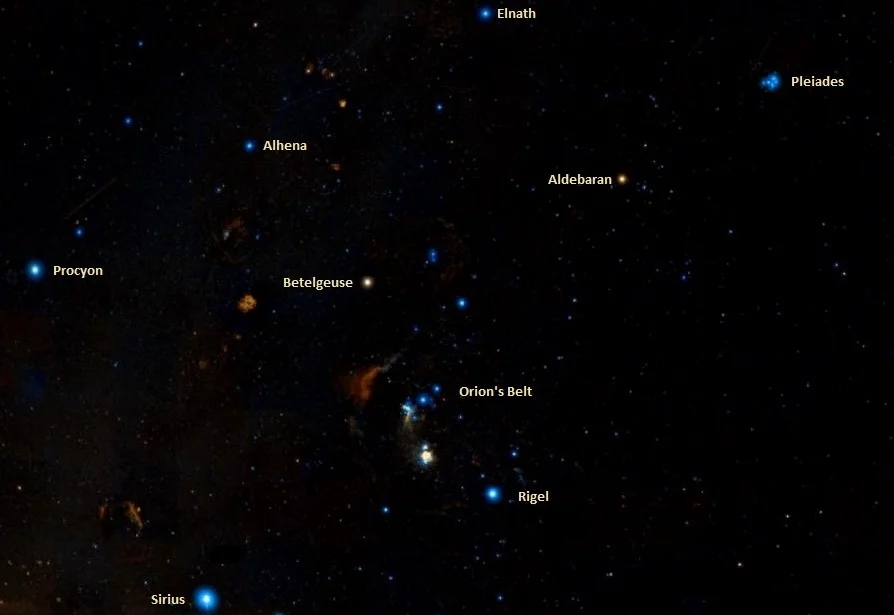
Pleiades location, image: Wikisky
The Pleiades can be seen rising prominently in the sky from October to April. The cluster cannot be seen in May and June, when it is too close to the Sun.
Constellation
Electra is located in the constellation Taurus. Representing the celestial Bull, Taurus is one of the oldest constellations in the sky, as well as one of the largest. It occupies an area of 797 square degrees of the northern sky.
The constellation is best known for being home to Aldebaran, the 14th brightest star in the sky, and the two bright, conspicuous open star clusters, the Pleiades and the Hyades. The Hyades outline a V-shape that represents the Bull’s head, while Aldebaran, appearing as the cluster’s brightest star even though it is not, marks the Bull’s eye.
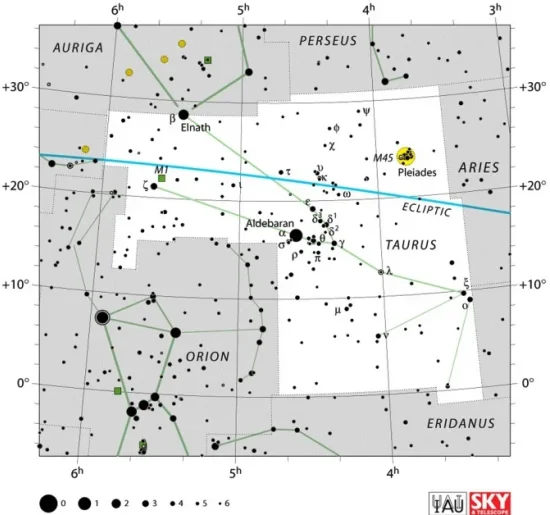
Taurus constellation map by IAU and Sky&Telescope magazine
Taurus contains several other notable deep sky objects. These include the Crab Nebula (Messier 1), the bright remnant of a historic supernova, Hind’s Variable Nebula (NGC 1555), a reflection nebula that varies in brightness because it is illuminated by the light of the young variable star T Tauri, and the Crystal Ball Nebula (NGC 1514), a planetary nebula named for its peculiar appearance. The constellation is also home to the supernova remnant Simeis 147 (the Spaghetti Nebula), NGC 1409 and NGC 1410, a pair of merging galaxies, and the relatively bright open clusters NGC 1647 and NGC 1817.
The best time of year to observe the stars and deep sky objects of Taurus is during the month of January.
The 10 brightest stars in the constellation are Aldebaran (Alpha Tau, mag. 0.86), Elnath (Beta Tau, mag. 1.65), Alcyone (Eta Tau, mag. 2.87), Tianguan (Zeta Tau, mag. 2.97), Chamukuy (Theta2 Tauri, mag. 3.40), Lambda Tauri (mag. 3.47), Ain (Epsilon Tau, mag. 3.53), Omicron Tauri (mag. 3.61), Atlas (27 Tau, mag. 3.63), and Prima Hyadum (Gamma Tau, mag. 3.654).
Electra – 17 Tauri
| Spectral class | B6 IIIe |
| U-B colour index | -0.40 |
| B-V colour index | -0.12 |
| Apparent magnitude | 3.70 |
| Absolute magnitude | -1.77 |
| Distance | 400 ± 10 light years (124 ± 4 parsecs) |
| Parallax | 8.06 ± 0.25 mas |
| Radial velocity | +10.9 km/s |
| Proper motion | RA: 20.84 mas/yr |
| Dec.: -46.06 mas/yr | |
| Mass | 5 M☉ |
| Luminosity | 940 L☉ |
| Radius | 6.06 R☉ (5.91 – 6.2 R☉) |
| Temperature | 13,484 ± 293 K |
| Age | 115 million years |
| Rotational velocity | 181 km/s |
| Surface gravity | 3.412 ± 0.047 cgs |
| Constellation | Taurus |
| Right ascension | 03h 44m 52.53688s |
| Declination | +24° 06′ 48.0112″ |
| Designations | Electra, 17 Tauri, HD 23302, HR 1142, HIP 17499, GC 4477, GCRV 2079, SAO 76131, FK5 136, AAVSO 0338+23B, BD+23 507, IRAS 03418+2357, PPM 92806, 2MASS J03445253+2406478, TYC 1799-1441-1, Gaia DR2 65271996684277504 |